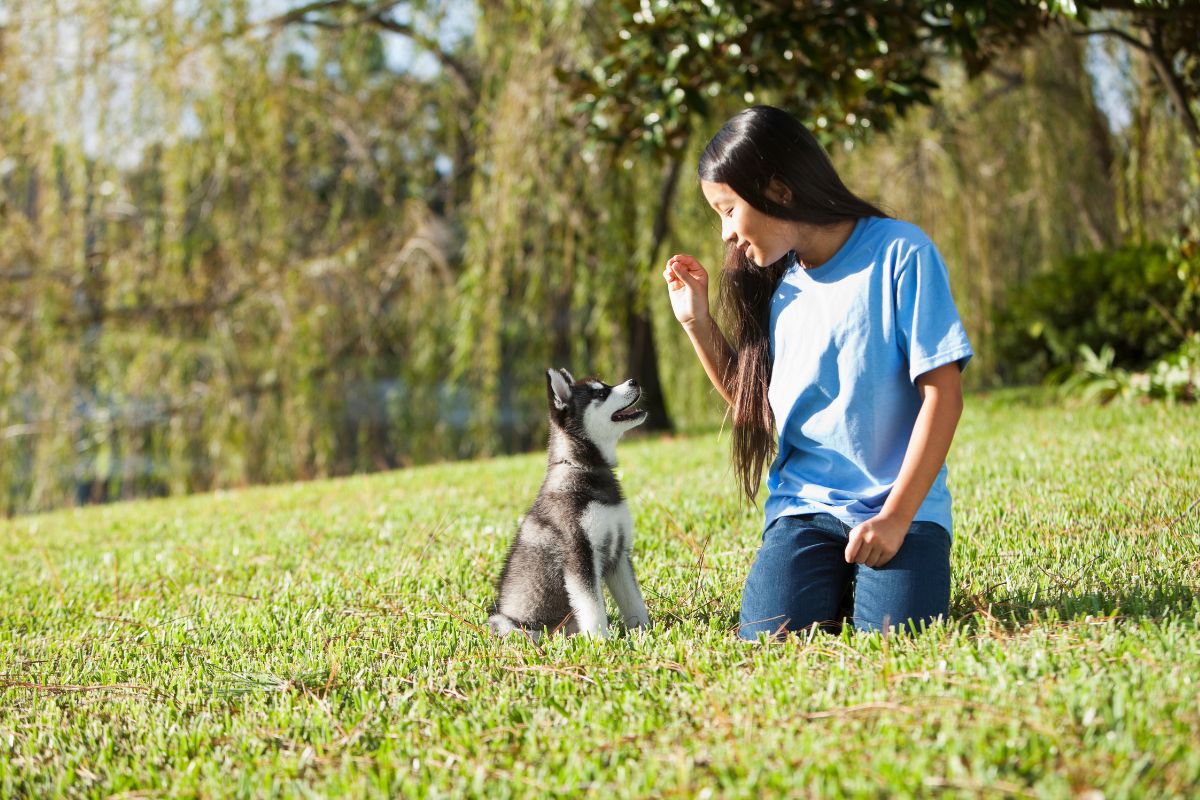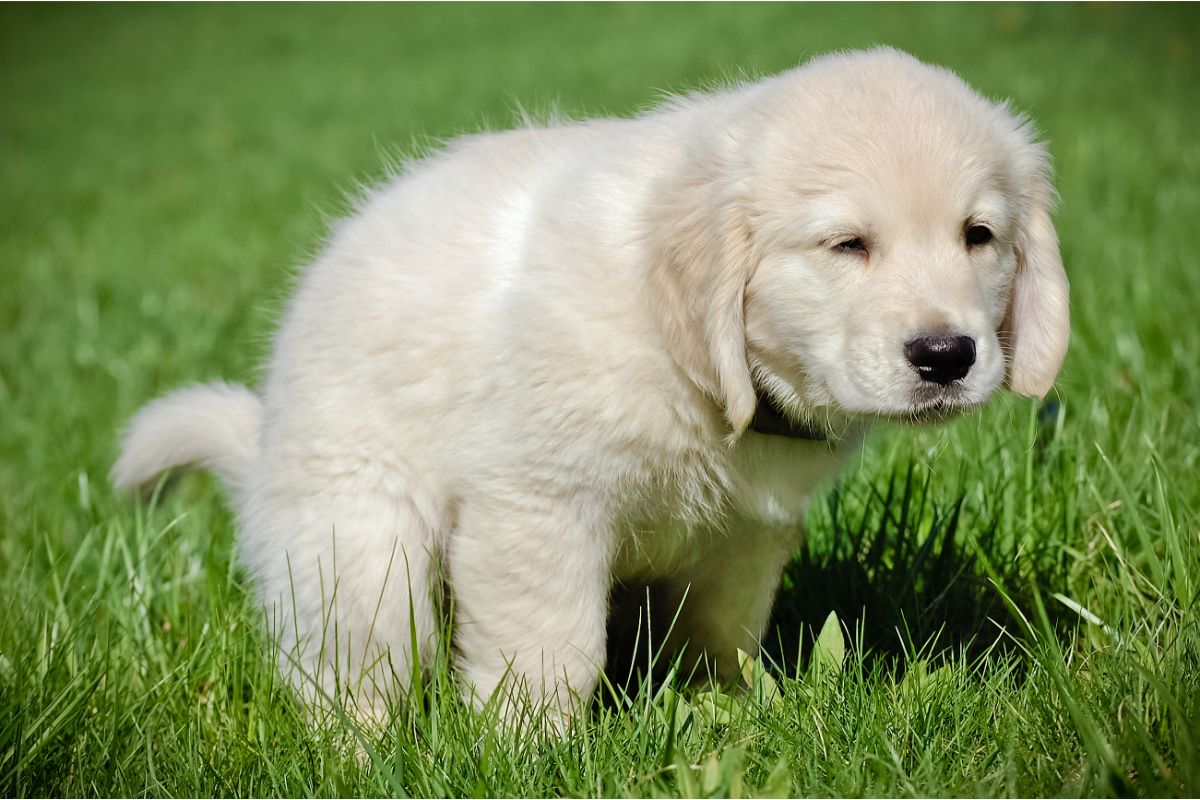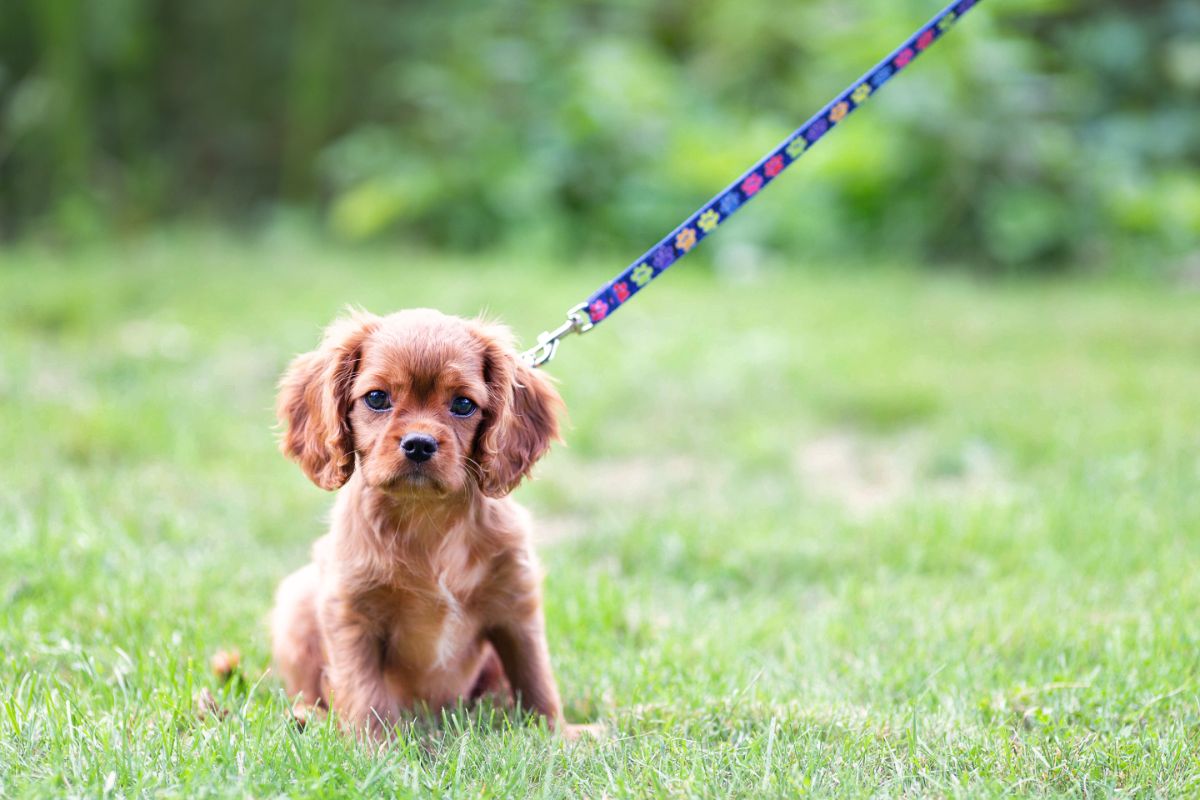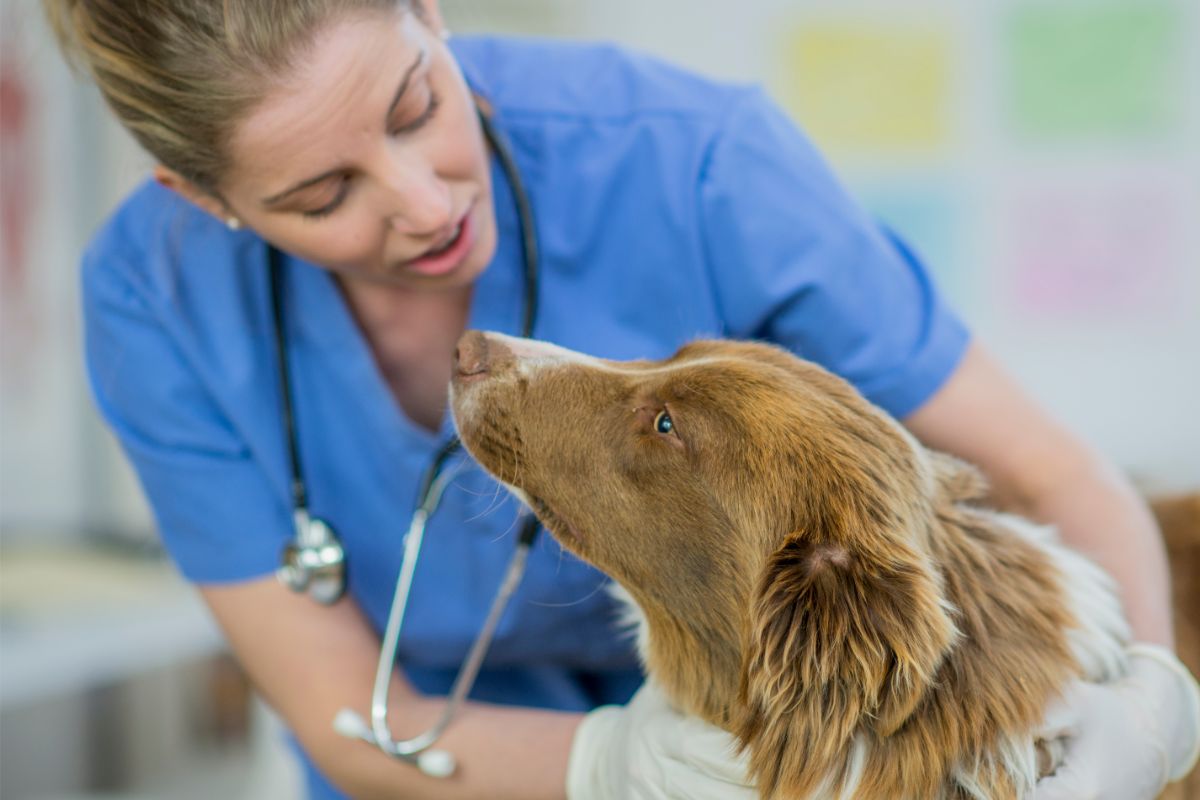If you have a puppy, then you may be wondering how to teach them the basics. With our guides, we can help you create a stronger bond with your dog, and teach them the rules of your home.
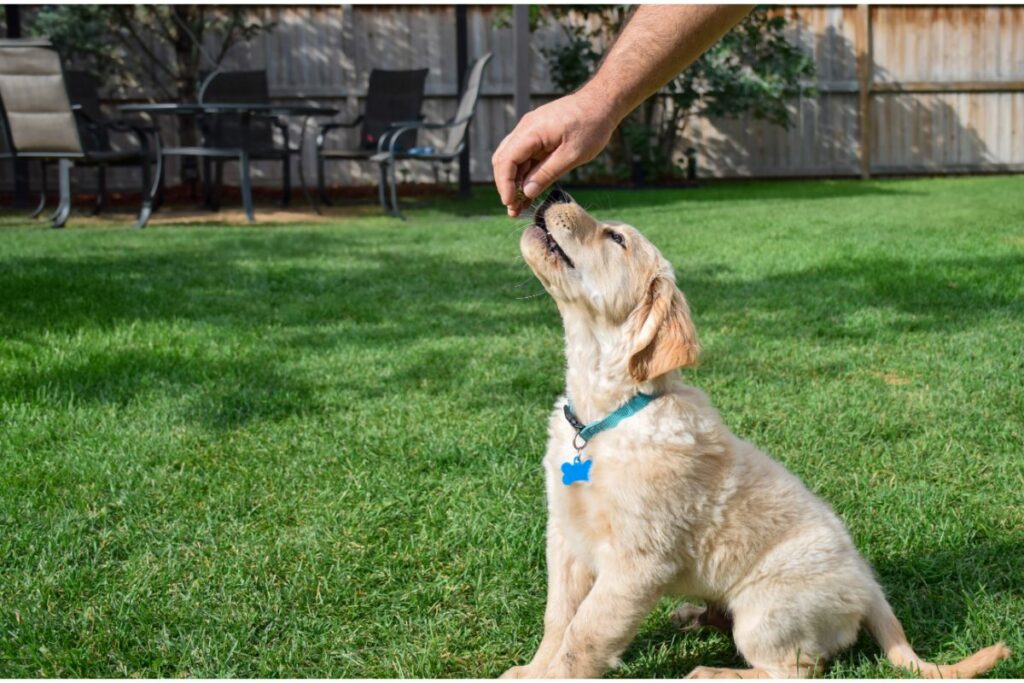
The basics of dog training are sit, down, come, heel, off, no, and of course- stay. Stay is a vital command that you must teach your puppy, as this can help them learn boundaries, and remain safe in all situations.
If your stay command is solid, you can prevent your dog from rushing out into the street when you open the door, or use it in an emergency so that your dog remains in place.
What Age Should A Puppy Learn To Stay?
You may be wondering at what age you should train your puppy to stay in one designated spot.
The truth is, you should start training your puppy from the moment you bring them home, which is usually around the 8 weeks age (see also “An Introduction To Heel Training For Puppies“).
If your puppy is older, or you have rescued a puppy that is a little past the puppy stage, you can still train them. The trick is to be consistent, and train them as soon as you bring them to your house.
If you begin training your puppy, you have to keep at it. Training takes time and patience, and you will have to repeat the training several times before it becomes ingrained in the dog.
If you want to teach your puppy to stay, then you will have to have already taught your puppy to sit and lay down. This can make it much easier to teach your dog to stay in a neutral position such as a ‘sit’.
It is also a good idea to teach your puppy to go to their ‘place’ such as their bed, mat, crate or other locations. From there, you can ask them to remain there with a ‘stay’ command.
How To Teach Your Puppy To Stay
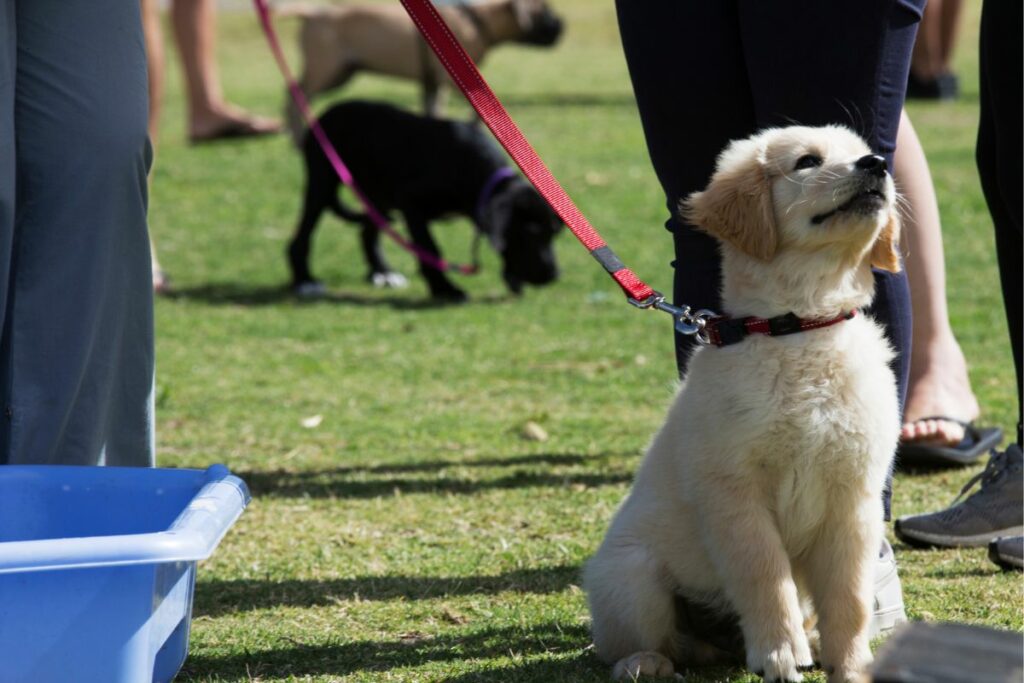
A ‘stay’ is a basic dog command that can encourage them to wait and to settle in a particular place.
The first step is to encourage your dog to go to their place. Once they have mastered a stay from this location, you can move on to having them stay on the floor, on an object, or anywhere in your home or outside!
So, if you are ready to teach your puppy the ‘stay’ command, then follow these tips.
Choose A ‘Place’
The first step is to select a neutral place for your dog to practice the stay command. This could be their bed, crate, on a blanket, or a mat.
Then, it will be much easier for them to locate this spot, and understand that they must wait and stay on it.
Clear Distractions
The next step is to control the environment in which you are in. To do so, you will need to remove all distractions.
For instance, if you have another dog, then have them in another room, or ask a family member to take them outside or on a walk.
Let other members of the household know that you are going to train the puppy, so you need to clear the space and not have any interruptions.
Start From A Down Or Sit
The next step is to ask your puppy to sit or to go ‘down’ in their place. Once your puppy has done so successfully, you will need to reward with a treat and a marker word such as ‘Good’.
Now, to implement the stay, you will need to use a hand signal. This is typically done with the palm of your hand facing outwards, much like a stop sign.
Say the command ‘stay’ and wait a few seconds while the puppy stays, and reward again with food and your chosen marker word.
Then, release your puppy by saying ‘break’ or ‘yes’ to allow them to leave their place. Then, reward them again.
Repeat this process over and over again, asking the dog to go to their place, have them stay, and then release them.
It will take around 5-7 times for this action to settle with the puppy, and for them to comprehend it.
Try A Leash
If you are struggling with a very excitable puppy, then you can try teaching the stay command while on a leash.
A leash can help you control your puppy while it is moving around and encourage them to go in the correct place.
Also, if your puppy tries to move while in the ‘stay’ position, then take a step forwards while holding the leash, and step closer to them, this can get them to settle down.
Then, once they are back in a sitting position, you can move back again and ask them to stay.
Reinforce
One of the best tips we can give you is to always reinforce good behavior. Always provide treats, vocal commands and affection when your puppy behaves in a way that you want them to.
This is the quickest way that you will get them to understand what behavior is correct, and what behavior is wrong.
Take A Few Steps Back
Now comes the most difficult part. You will need to get your puppy to remain in the ‘stay’ position while you take a few steps back from them.
Once you can do this successfully, you can start to extend the duration of the ‘stay’.
So, now that your puppy can successfully stay in their place, you can try taking a few steps away. To do this, have your puppy go to their place, and make them ‘sit’ or lie down.
Now, do the stay command as normal, and as your dog stays and is focusing on you, use the hand signal with your flat palm extended to them, and start to take a few steps back.
The steps backwards should be slow and steady. Fast movements can incite your puppy to chase you.
If your puppy has remained in their place, then you can release the puppy after a few seconds with ‘break’ or ‘yes’, and reward them.
If your puppy did not stay, then take them back to their place and start over. They may not do it perfectly the first time, so remain positive and keep trying!
Start off with 2-3 small steps away at first, and slowly build up to more, until there is a good distance between you and the puppy.
When your puppy can do this successfully, you can start thinking about practicing the ‘stay’ position when you leave the room.
Leave The Room
The final step is training your dog to ‘stay’ is to build up their confidence and newly-learned ability while you leave the room. This can be hard for the puppy as they will no longer be able to see you.
You can do this in the same way you trained your puppy while you took a few steps away. Just extend the steps away, and back out of the room.
Wait a few seconds, and release them, or return to them, before rewarding them again.
You can even further their training by extending the duration of the time that you are out of the room. Start with 5 seconds, build up to 10, 20, 30, and even a full minute.
Be sure to practice the ‘stay’ command on a range of surfaces.
Try to practice when your puppy is staying in their bed, on the floor, on a mat, in their crate, until the command becomes easy no matter where they are.
How ‘Stay’ Can Help With Impulse Control
Stay is an essential training command that all dog owners need to teach their dogs.
Not only does it help you establish some boundaries with your dog, this can also limit anxious behaviors when you’re not with your dog, and help them be more confident staying in a room by themselves.
If out on a walk, and suddenly a dog, vehicle, or animal comes out of nowhere, you can ask your dog to ‘stay’ and prevent them from becoming at risk.
Stay is also a vital command that can help you teach your dog impulse control, and understand thresholds.
Thresholds are what we call doors, gates, and any openings that your dog will need to wait at before walking through.
Whenever you open a door, it is likely that your puppy wants to rush out of it straight away. Dogs don’t think about the fact that there could be cars on the road, or hazards outside before they go running.
Using the stay command before you let your dog outside can help control their impulses.
So, as you approach a doorway, ask your puppy to sit, and tell them to ‘stay’. When they are in the stay position, they will likely look at you and focus on you, waiting for the ‘break’ or release.
Only when they make eye contact should you release them from the stay position.
When you open the door, they will likely rush out anyway. Instead, open the door very slowly, and at small increments at a time.
If your dog goes to move, close the door gently. Repeat until your puppy realizes that they have to wait for your command.
So, have your dog sitting at the door, ask them to stay. Begin opening the door slowly, and when they make eye contact with you say ‘good’ and release them.
It is important that you go through the door before the dog, so that they know that you are the leader, and they can only cross through when you go first.
This reminds them that they have to sit and stay, make eye contact with you and wait until they can go through the door.
You can keep practicing this so that you are able to open a door fully, with your dog waiting for your release before you both go through the door.
So, your threshold training should look like this:
- Have your puppy sit at the door
- Command the puppy to wait
- Slowly being opening the door
- Ensure the puppy is making eye contact
- Fully open the door and begin walking through as you say ‘Good’ or ‘Yes’
- Walk through the door before your dog does.
Be aware that this can take a lot of time, patience and practice for your dog to not want to rush through the door.
Dogs are impulsive, and have a natural drive to want to rush through the door and go explore outside.
With practice and positive reinforcement, your dog will soon come to understand that they need to sit and stay before they are allowed to go through a door.
You also need to be consistent with the training. Every time you open the front door to go for a walk, ask them to sit and stay.
Every time you go to let your dog outside to go to the bathroom, ask them to sit and stay before releasing them.
Final Thoughts
To summarize, teaching your puppy to stay is an integral part of their training. A ‘stay’ position can help your dog learn how to wait for your command, and get used to you being away from them or out of the room.
It can also keep them safe in many situations, especially in emergencies.
One of the biggest benefits of a ‘stay’ command is that it teaches your puppy about thresholds, impulse control, and prevents them from acting on their every impulse to run to you or to run outside without thinking.
- How To Teach Your Puppy Their Name Easily! - July 18, 2023
- Is Your Puppy Counter Surfing? Find Out How To Stop It! - July 18, 2023
- How To Train Your Puppy For Car Rides: Everything You Need To Know - July 18, 2023



